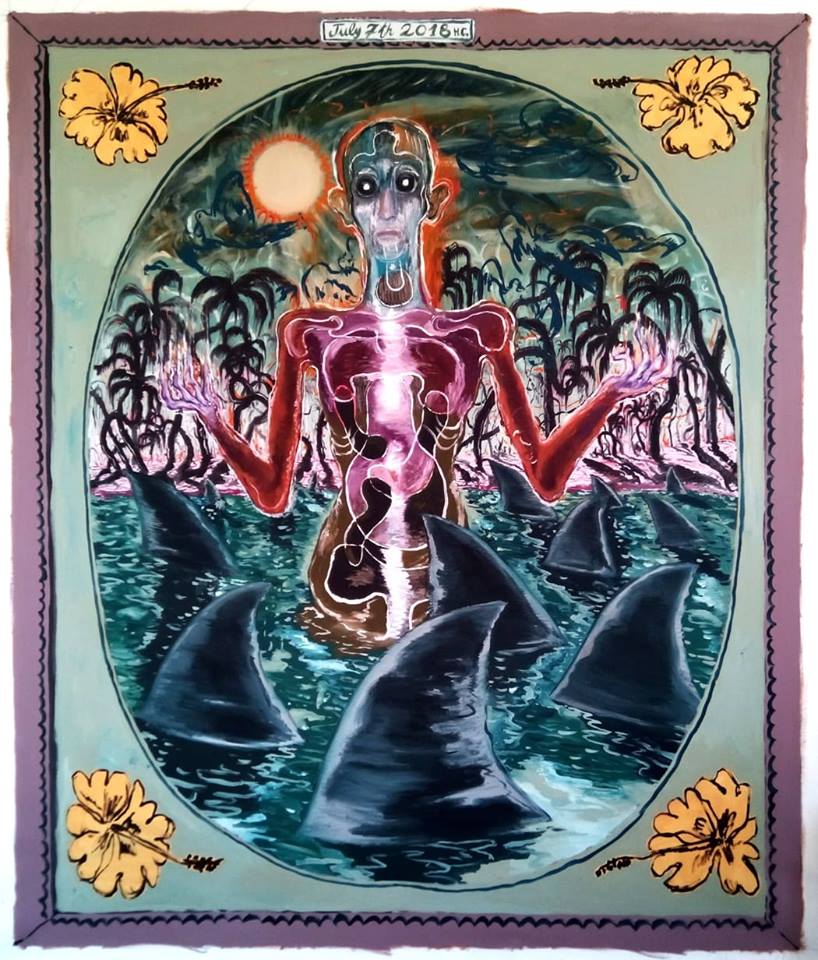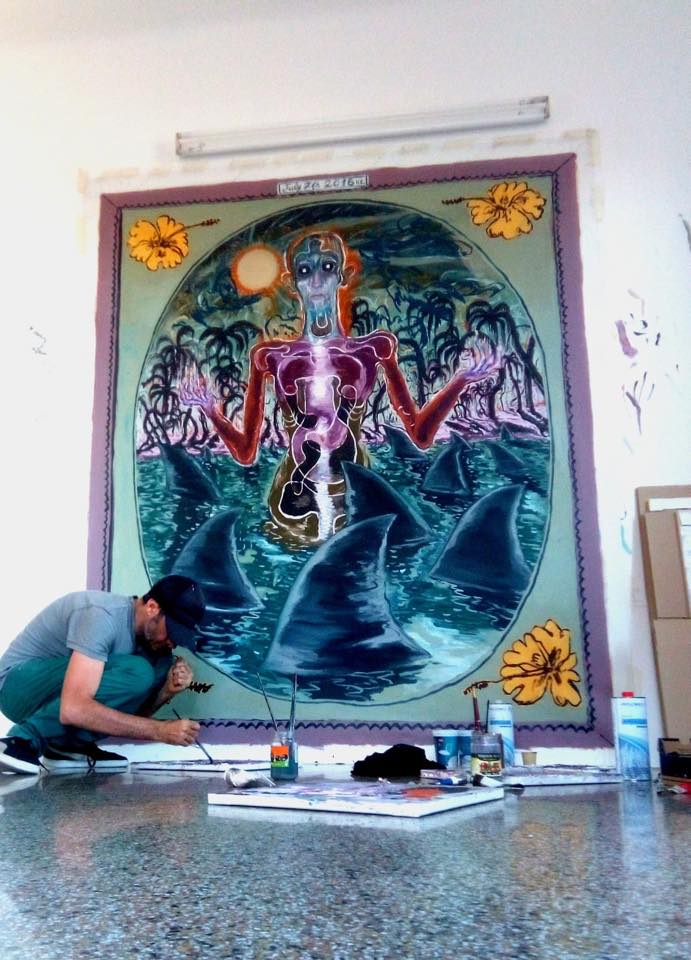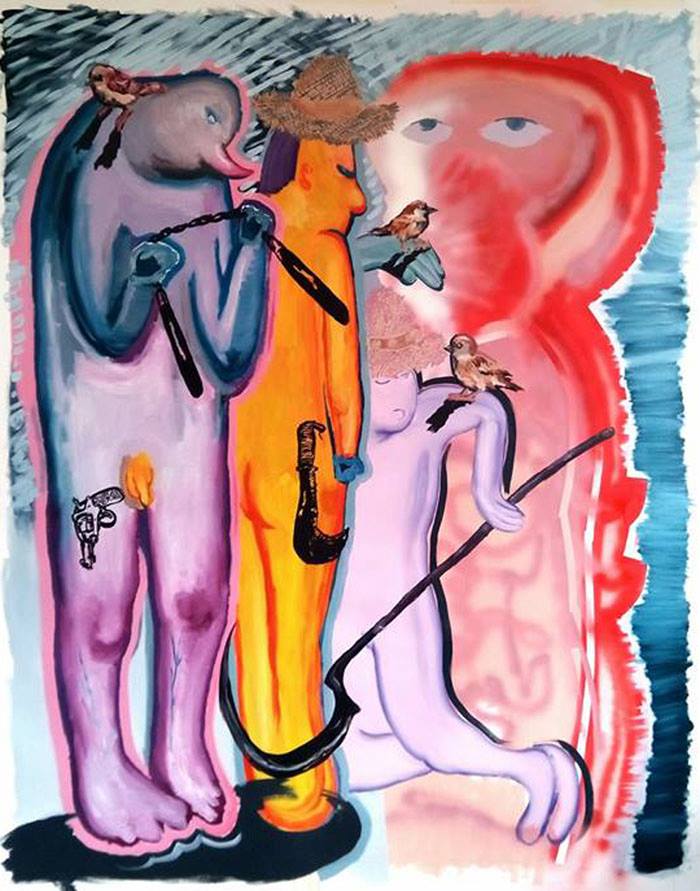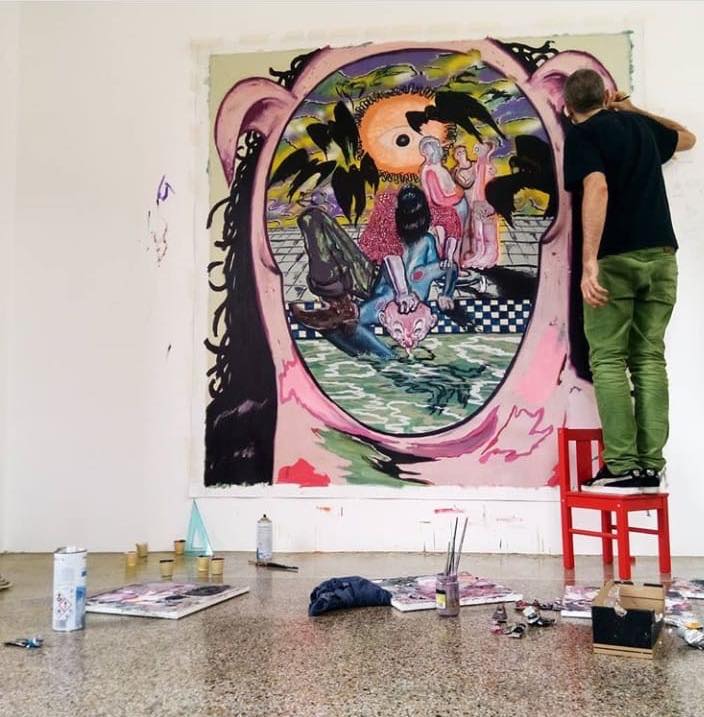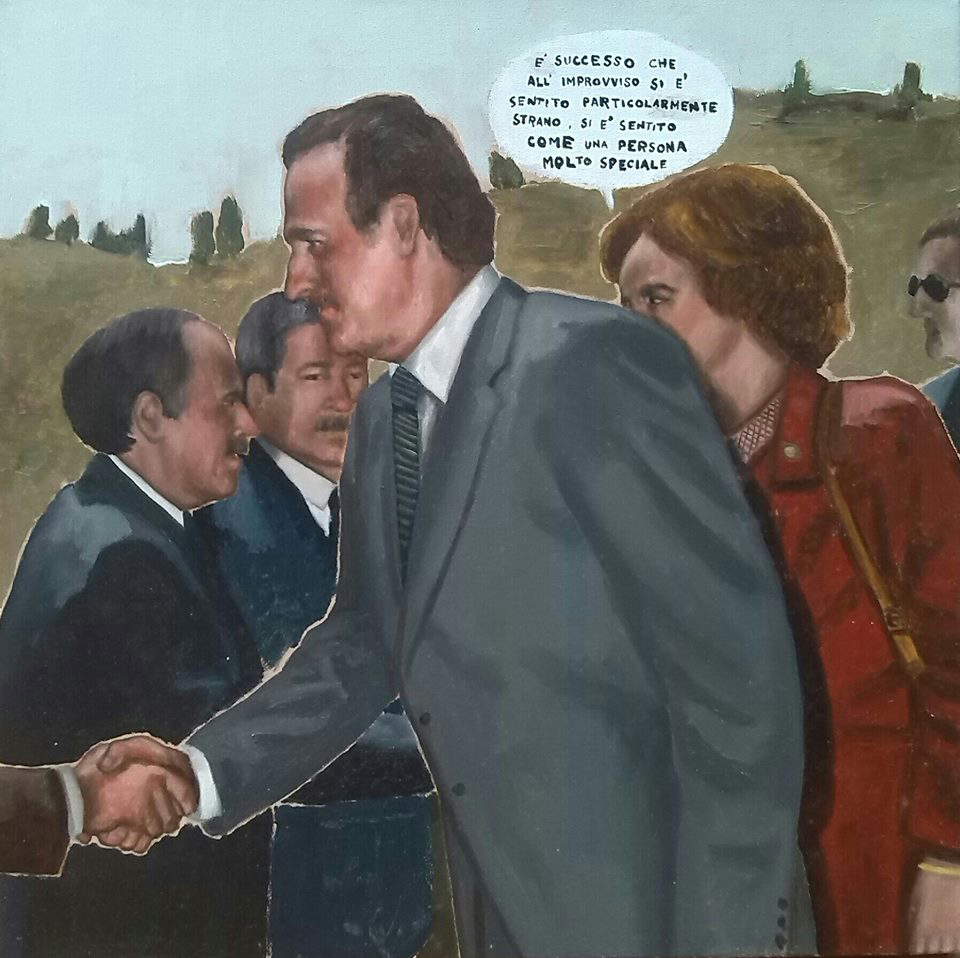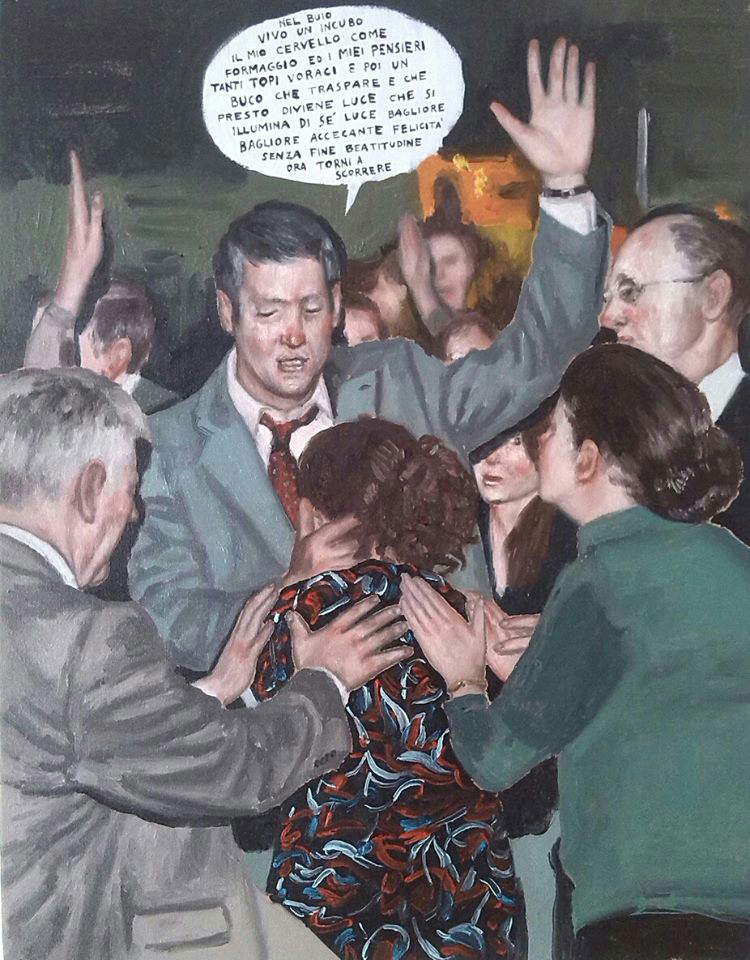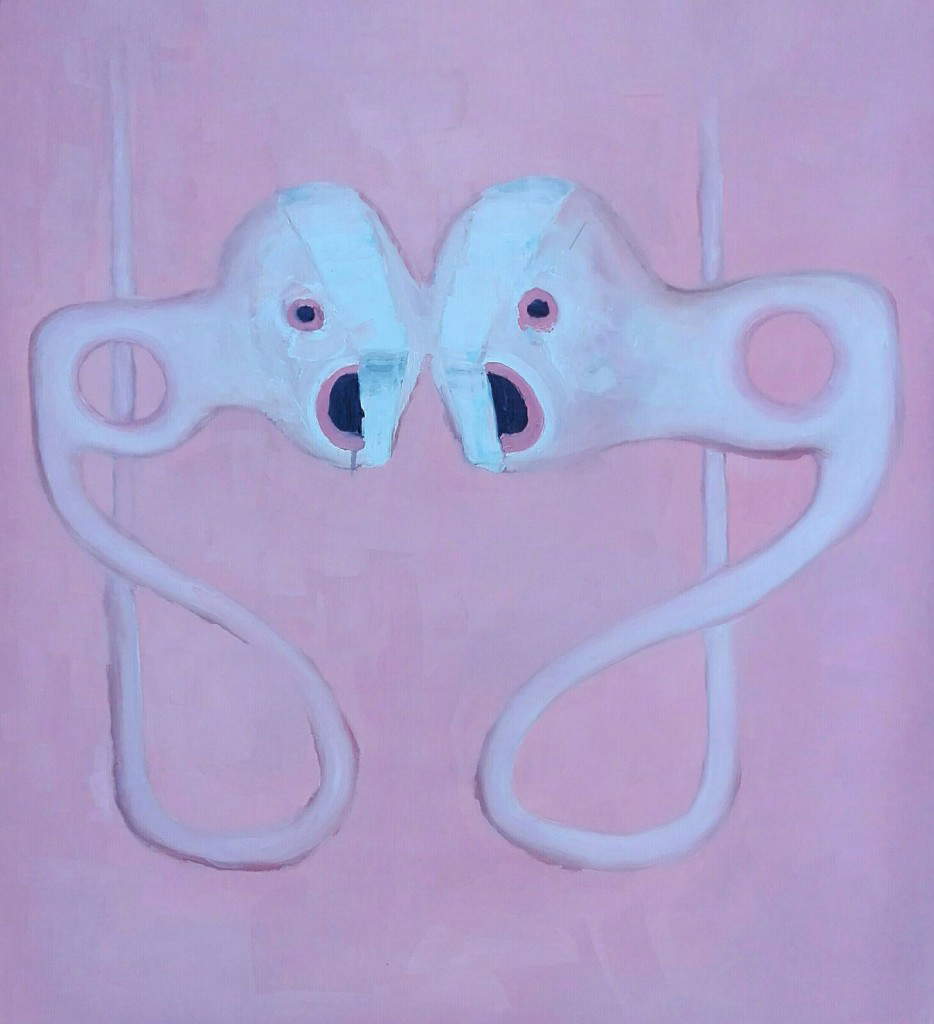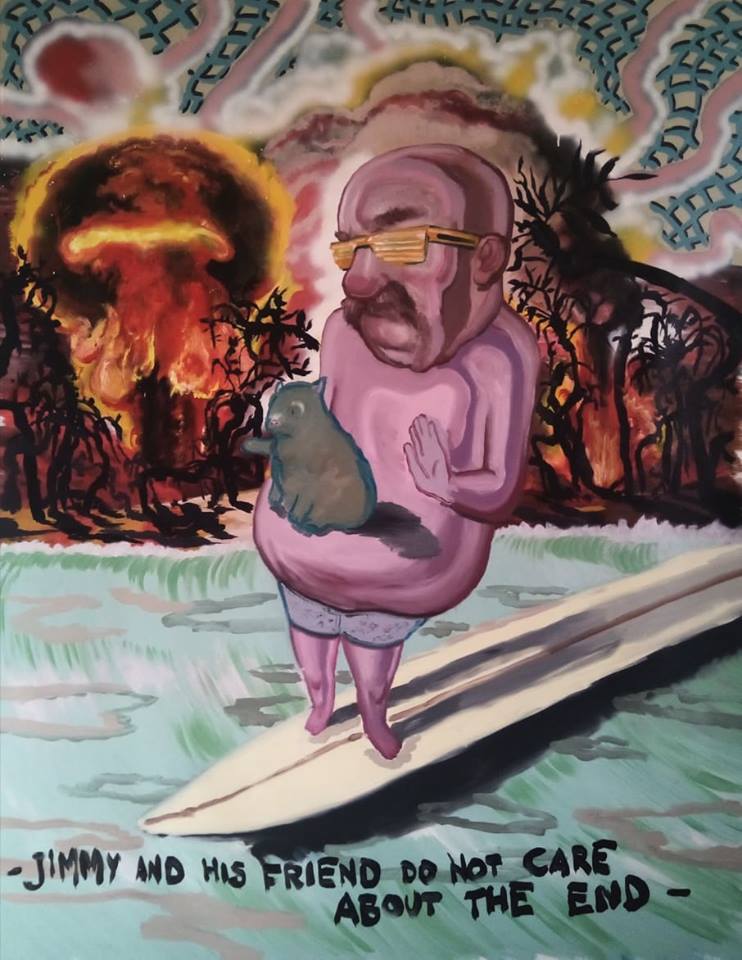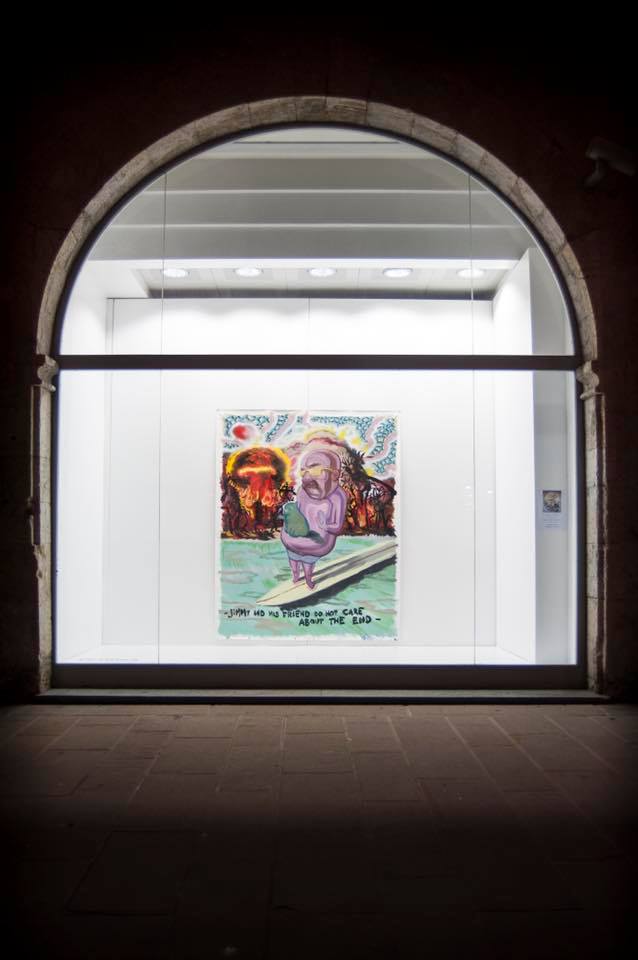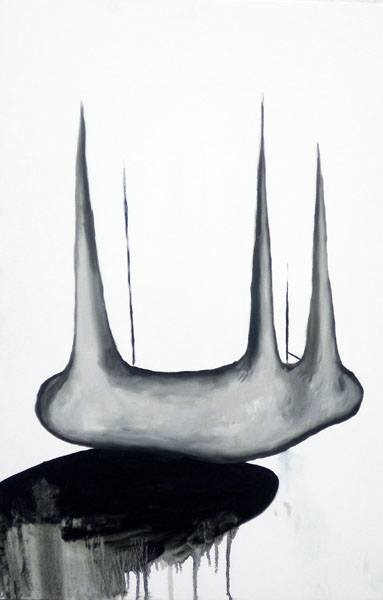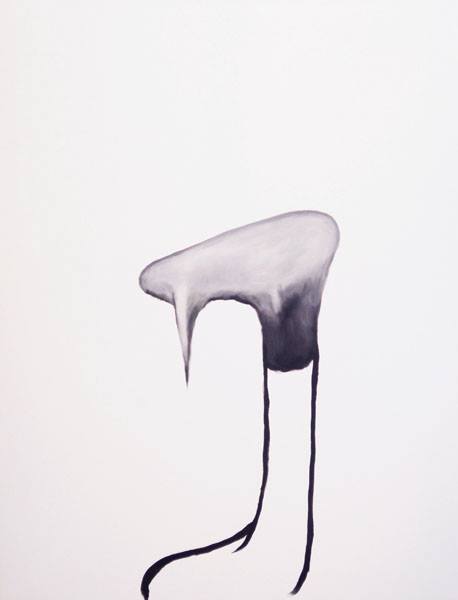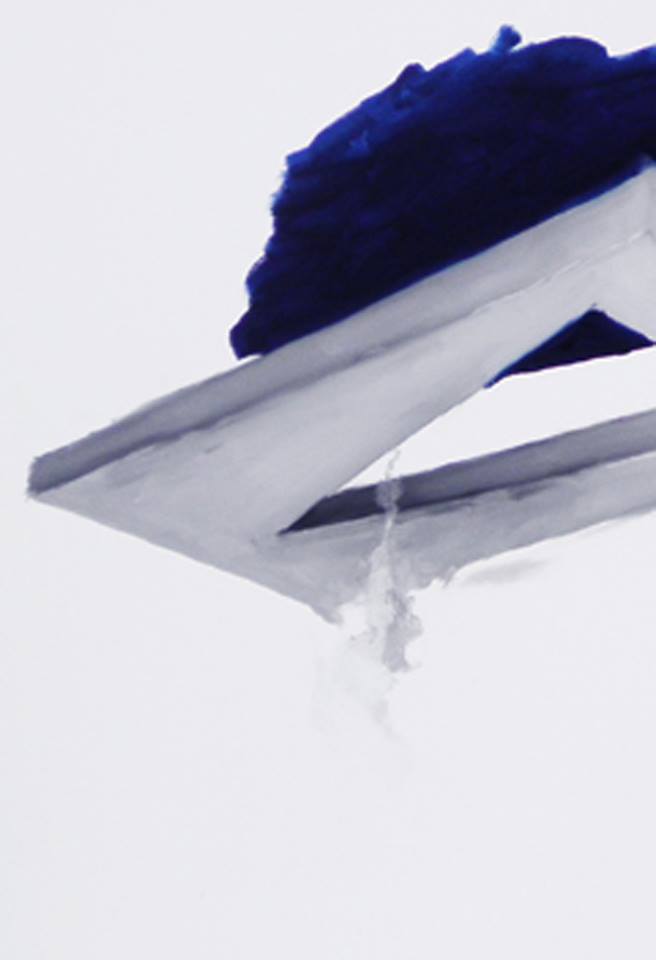by Federico Giannini (Instagram: @federicogiannini1), published on 24/09/2018
Categories: Interviews
/ Disclaimer
Interview with Roberto Chiabrera (Genoa, 1970), one of the most interesting contemporary artists on the Italian art scene, who offers strong, visionary and disturbing art.
Roberto Chiabrera (Genoa, 1970) is, in our opinion, one of the most interesting artists on the contemporary Italian scene, and perhaps too underestimated: his is an art out of the box (at least out of the Italian box, because there is nothing Italian about it), which does not leave those who observe his paintings indifferent. Tormented and the result of an uncommon sensitivity, Roberto Chiabrera’s art is all-encompassing, and references range from music to literature, from painting to everyday life. We had him tell us about some of his work directly, and we tried to delve into his vision of art in general. Interview conducted by Federico Giannini.
FG. Let’s start with your latest exhibition, “Hello there,” which was held at the Ricci Gallery in Carrara this summer.
RC. It was an exhibition where I showed figurative paintings, works where I tried to be more free, telling a part of me. I give some examples. In one of these paintings, which I called Hawaiian Chemistry, I started from the idea of fear of the shark, a phobia that I have always lived with and carried for a long time. The protagonist of the work is a person who looks almost like an alien, and who seems to be praying, somewhat against the light, and has, in the chest and abdomen, almost stylized organs, which are, however, invented, not corresponding to the real organs. The hands are praying, separate but facing the sky, and the figure is submerged in water up to his hips and surrounded by shark fins. It is as if he is somehow praying to direct these animals in order to render them harmless. And behind him is a catastrophic island landscape, with palm trees from a tropical island, but they are distorted, bent, black, they look almost burned, and in the sky appear these birds that are scattered against the light, since they are blue on the blue base of the sky. I did not want to frame the picture: although it is canvas, I wanted to paint an oval frame with Hawaiian flower decorations on the four sides of the canvas. And at the top, a date appears, which I wanted to affix as the start date of the painting, July 7, 2018: this is because I wanted to give a precise date to the event, as if the protagonist was a kind of Christ-like saint resurrected from the water, able to eventually succeed in overpowering the sharks. Then I continue to work on smaller, cartoonish paintings: in Hello There I exhibited one in which I wanted to create a slightly sicker scene, inspired by music, which along with surfing is one of my two great passions. Almost all of my works start from music: although I know the contemporary art scene (and the Internet and social media help me a lot in this, with which you can really visit galleries all over the world, and I see hundreds if not thousands of images all the time), music remains the main point of reference for me. In the painting we have for protagonists some farmers, who go to worship the spray-painted figure that appears behind. They are turned toward this sort of deity: and I imagined them to be malicious, evil (so much so that they are all armed) simply because of the fact that I also imagined them to be ignorant. There is ignorance at the root of the evilness of these people. Another painting that is important to me is Metal Boy, a further return to my passion for rock and metal music. Here we see a person trying to throw into the water of the pool a creature that looks evil, but in fact may not be, because in the end we are not clear where the evil lies and where the good lies: a feeling also reinforced by the fact that the characters in the background are almost indifferent to the scene, they are indifferent to the violence. I like to create things that hang in the balance, partly because then in the end ... they are not very clear to me either!
 |
| Roberto Chiabrera, Hawaiian Chemistry (2018; oil on canvas, 195 x 230 cm) |
 |
| Roberto Chiabrera at work on Hawaiian Chemistry |
 |
| Roberto Chiabrera, Be aggressive harvester (2018; acrylic and oil on canvas, 165 x 215 cm) |
 |
| Roberto Chiabrera, Metal Boy (2018; acrylic and oil on canvas, 167 x 230 cm) |
 |
| Roberto Chiabrera at work on Metal Boy |
These researches however come after a career that has gone through different phases: your art undergoes transformations all the time...
I work mostly ... in periods. In the last two years I’ve been working on very instinctive works-I have to say that I’m quite a confusing person, and the latest works are not very thoughtful. Before, on the other hand, I used to work a lot on particularly elaborate works, on “concepts,” in the sense that a painting was made up of several paintings, which could be as many as five or six, mostly in a small format. They were short stories to which I always tried to infuse this spirituality that somehow accompanies me, where I tried to talk about evil and good. For example, to deal with these themes about ten years ago I created a series (at that time I was working on series, and all the paintings were titled with the name of the series, I never gave titles: now instead I focus more on individual works), titled Projema, where the protagonists were people intent on worshipping something or simply getting to know each other, and their actions were accompanied by comics. And then there was always a person who was charged with saving the world from illusions. However, I didn’t really know from whom he received the assignment: it was always so confusing, and I had imagined the story as the story of a new Jesus, as the story of a new resurrection. And yet at the same time this character had an appointed time for his mission of salvation, but nevertheless he was failing in his operation. I spent long periods of time looking for images of healers, of hermits, of preachers who could guide me in the depiction of this sort of society whose members, in the end, always went against this person who was supposed to save them, and who was in the end punished in a sense. They were very elaborate paintings, I used to spend a lot of time on the works, I used a very meticulous oil technique, careful about the colors, the shadows. I used linen canvases, very expensive colors. Later I experienced almost a kind of rejection towards the technique, because I couldn’t take it anymore to paint very detailed works. So I sought annihilation, I sought a kind of abstractionism with paintings where I got rid of everything of this laborious, precise painting. And for me it was a liberation: I erased everything, I began to use colors as they came to me, without worrying about the result. For a while, I continued with this particular form of abstractionism and then sought a more hybrid form, as in the Vision series, in which I started from the thought of a person losing cognition, getting up one morning and starting to live a different life, a parallel life. A person caught in a form of dementia, a kind of Alzheimer’s, and starting a totally different day than what he was before. With the latest works I have again gone back to a more figurative art, the one I am traveling now, but which I still feel is freer, more executed on the spur of the moment, without me fussing about measurements and details.
 |
| Roberto Chiabrera, Projema series (2006; oil on canvas, 30 x 31 cm) |
 |
| Roberto Chiabrera, Projema series (2006; oil on canvas, 27 x 35 cm) |
 |
| Roberto Chiabrera, Vision (2016; oil on canvas, 80 x 80 cm) |
 |
| Roberto Chiabrera, Vision (2016; oil on canvas, 120 x 100 cm) |
 |
| Roberto Chiabrera, Vision (2016; oil on canvas, 80 x 80 cm) |
 |
| Roberto Chiabrera, Vision (2016; oil on canvas, 120 x 100 cm) |
 |
| Roberto Chiabrera, Vision (2016; oil on canvas, 120 x 100 cm) |
 |
| Roberto Chiabrera, Vision (2016; oil on canvas, 100 x 80 cm) |
What effects has this path had on your technique? How are you working now?
I started using a lot of color again, something I had put aside a bit. I am also using acrylic and spray bases, whereas previously, as mentioned, I used mostly oil. I like bright colors: some orange, pink and blue flecks, which with oil I couldn’t get as well as with spray. The inputs I get when I work on a painting already come to me the moment I start scribbling an image, but then everything is always modified in the process, the details come and then disappear, and my technique is also quite fast because once I fix an idea for me it is really essential to finish it, to bring it to completion as soon as possible. I can’t stay on the work any longer, in fact I want to hurry, I have to work fast... I consider myself a perfectionist, but everything has to be done quickly: mine is a very neurotic process, and for that reason I have to act fast. And above all I would like to say that art for me is a necessity. I feel the need to have to paint and make ... and perhaps that is also why I have never been attached to my works: there is something I prefer, but nothing prevents me from detaching myself from it. I reiterate that art for me is a necessity, but at the same time I have to get rid of it: what I do has to go. It sounds like a stretch, but that’s how it is for me.
Let’s go back to talking about recent work. In Pietrasanta, just this year, you exhibited, at Banco BPM, one of your latest works, Jimmy. Who is Jimmy, and how is he representative of your art?
Here again there is a reference to my passion for surfing. Here again we find a devastated landscape, with the results of an atomic explosion, there is a grotesque component (the movie Dr. Strangelove comes to mind, but also Apocalypse Now), and I named the painting Jimmy because that is the name of the character who is surfing, although behind the choice of the name there is no specific reason, it just occurred to me to call him that. Behind him there is catastrophe, there is the end of the world, but he gets over it by simply surfing with his friend, a kitten. The meaning of the work and the way it is representative of my art is summed up by the writing underneath the two protagonists, which reads “Jimmy and his friend do not care about the end.” What I really thought is that strong passion can win over tragedy-Jimmy actually does not think “who cares about the end of the world,” he is not indifferent to what happens behind him, but he wants to take advantage of that last moment to catch his wave.
 |
| Roberto Chiabrera, Jimmy (2018; acrylic and oil on canvas, 167 x 235 cm) |
 |
| Jimmy exhibited at Banco BPM in Pietrasanta, Italy. |
Going a little further back in time, however, it has been said of your 12 Hours project that “it was born out of a dramatic experience, out of agony and death,” and that it was a project “in which painting becomes a protest against pain and a means of reworking it.” Can you tell us in more detail about that project and what gave rise to it?
It is not very easy for me to talk about this exhibition, because at that time I had erased everything that was the figure for me: I wanted to estrange myself, although then in the process of putting it together, in my head, there was always the figure. 12 Hours was inherent in a tragic event in my life, which I have now processed. The figures that appeared in the paintings in the series were almost anemic, white, cast figures, some angular, geometric, tending toward the built, architectural, machine-like, and some round. The angular shapes represented machinery, architecture. The softer, rounder ones, on the other hand, gave the idea of the softness and fragility of the body, but also the fragility of humanity and our thinking, as well as representing psychophysical decay. And in certain passages these features blurred. They were all monochromatic canvases, in shades of white, gray and black, with the background of the canvas left white. They were canvases made almost on the spur of the moment, reasoned more at the sketch level and then fixed on the canvas very quickly. In this series I wanted to make an effort to accept a reality, I tried to be okay with everything I was representing, to not make a problem about the feedback from the public, the feedback I would receive: everything I was doing had to be okay with me. And it was after this exhibition that I went back to figurative.
 |
| Roberto Chiabrera, 12 hours (2014; 40 x 60 cm) |
 |
| Roberto Chiabrera, 12 hours (2014; 50 x 70 cm) |
 |
| Roberto Chiabrera, 12 hours (2014; 50 x 70 cm) |
Indeed, yours is a difficult, provocative and somewhat disturbing art. Is there a relationship that your work seeks with the viewer?
I think not. This tragicness that I try to externalize is not easy for the public to accept, also because, moreover, it is something very intimate, and yet it is disturbing. I think in Italy we are a bit scared, we don’t dare, there is no research that pushes us to try something different than what is reassuring we are used to seeing. We are a bit stuck in Italy: maybe we have too much history, maybe we have stopped on our past, fallen asleep on the past, forgetting to take important steps forward, toward a direction that could be ... any. I myself do not believe that I make such powerful art, but at the same time I understand that it is not easy, also because I sometimes experience difficulties in presenting my paintings. And I have always experienced this public response on my skin, also because my art is something that involves myself. But I realize that sometimes we also tend to want to keep quiet about certain topics: we would always want art that appeases.
And that is why the references of your art, so strong and so visionary, probably have to be looked for outside Italy. Personally, for example, I would choose you if I had to illustrate a work by William Burroughs, and among your figures I think I glimpse artists like Bacon, Basquiat, Condo, Anna Boghiguian, but also underground culture, a good dose of pop art... However, I want to ask you: what are your artistic and cultural references?
I look at everything, store and rework everything. Speaking of Bacon, right here in front I have two giant books on his work. But at the end of the day, when I transfer the inputs to the canvas, I think Bacon is very far away, although maybe it stays in my mind. This is also to say that my references range a lot and even go beyond art. For example, I could cite the books of Bukowski, Kurt Vonnegut, who is an important reference for me (his very bitter irony is a trait that inspired me a lot), I could cite music, from hardcore to punk to rock. The art form that I would perhaps mention the least is painting, but again there are works that I appreciate. One artist I really like is Raymond Pettibon (he also, by the way, draws surfers). Then I really like Michael Borremans even though he is very far from what I do, and likewise I appreciate those who do very instinctive painting, for example Tala Madani with her backlights done with spray and oil, or Sanya Kantarovsky, author of fast and even a bit sick works, because we often find characters on the edge, like the man who maybe is in bed observing the little girl in an ambiguous way, or who takes the hand of a child to take him who knows where. I certainly consider myself distant from conceptual art: mind you, I appreciate a lot of conceptual art, but I don’t find myself in it. And that’s especially in terms of the better-known names, except maybe Urs Fischer, who is a little closer to a little more punk art. But the big names in contemporary art, such as Ai Weiwei, Damien Hirst, Jeff Koons, say little to me. I prefer Alex Katz’s paintings, I think they are wonderful. And more generally I am inspired by life and music, I always feel close to the younger universe, I like for example the world of skateboarding and surfing. Although I never fail to always check out everything anyway. I use Instagram a lot-I find it a useful way to get informed about everything that is happening in the art world and galleries.
What do you think about contemporary Italian painting instead? Are there colleagues whose work you look up to or whose work fascinates you?
In my opinion we are always bogged down, and I can’t see anything that arouses particular feelings in me. I could mention Alessandro Pessoli, but he has a very American approach to art, or a very good artist like Thomas Braida. In Italy we still give too much attention to the figure, just look at the winners of all the major competitions. Of course: that may be right, but I don’t see anything particularly innovative. Maybe there was more ferment a few years ago, but now we really struggle to let go, we don’t try. In short, in my opinion there is nothing that can shake things up. There is a tendency to paint the reality that you live, to paint what you know. There is a need to go out, to make something that one has not seen, that does not exist. Then one can often fall into works that can be perceived as ugliness, with the consequence that the public, when they see them, thinks they are dealing with “disturbing” art ... a term that, by the way, I hate: but in my opinion it is good that art is disturbing, because, as per the etymology of the term, it means that it ruins the quiet. A field of flowers or a still life hardly ruins the stillness (or rather, to me it does, but so many others observing similar works experience pleasant feelings). Art must leave us perplexed, otherwise it is meaningless. For me it does.
Warning: the translation into English of the original Italian article was created using automatic tools.
We undertake to review all articles, but we do not guarantee the total absence of inaccuracies in the translation due to the program. You can
find the original by clicking on the ITA button. If you find any mistake,please contact us.
